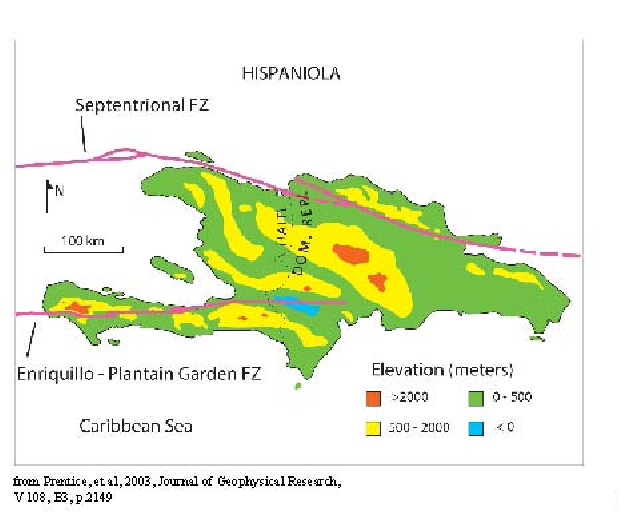Seismo Blog
Devastation on Hispaniola
Categories: Haiti | Caribbean Plate | Plate Tectonics
January 13, 2010
The devastating earthquake, which shook the Caribbean island of Hispaniola and a large area of the Greater Antilles on Tuesday afternoon, may have cost tens of thousands of lifes. Haiti's capital Port-au-Prince was particularly hard hit, because the distance from the focus of the shallow quake to the city center was less than 12 miles. Tuesday's quake had a magnitude of 7.0, which makes it comparable in size to the the last big temblor in the Bay Area, the Loma Prieta quake of 1989 (see blog 16 October 2009).
The Caribbean region, often sold by tourism promoters as "tropical paradise", is no stranger to natural disasters. Four hurricanes made landfall in Haiti alone during the 2008 season, causing widespread destruction. In addition, earthquakes and volcanic eruptions are almost daily occurrences, because most Caribbean islands lie close to a major plate boundary. In this region, the giant westward drifting North American Plate encounters the much smaller Caribbean Plate, resulting in a complex pattern of interaction. In the eastern region this plate collision leads to the formation of a subduction zone, which in turn gives rise to the gentle arc of the Lesser Antilles. As in many other subduction zones most of these islands are of volcanic origin. During the last 15 years the almost continuous eruption of the Soufriere Hills volcano has destroyed more than half of the island of Montserrat. A gigantic explosion of Mont Pelée volcano on Martinique in 1902 cost more than 65000 lives.

The northern part of the plate boundary lies close to the islands of Puerto Rico, Hispaniola und Jamaica. There the plates rub against each other horizontally, very similar to the plate movement which governs California. But while the relative motion along the major faults in our state is right-lateral, North America slides westwards with respect to the Caribbean, resulting in a left-lateral movement along the fault (see black arrows in figure 1).
The northern part of the plate boundary lies close to the islands of Puerto Rico, Hispaniola und Jamaica. There the plates rub against each other horizontally, very similar to the plate movement which governs California. But while the relative motion along the major faults in our state is right-lateral, North America slides westwards with respect to the Caribbean, resulting in a left-lateral movement along the fault (see black arrows in figure 1).
While this fault line is clearly defined by a deep sea trench near Puerto Rico, the boundary zone is much wider under Hispaniola. The larger Septentrional Fault runs along the north coast of the island, while a secondary fault system, the so called "Enriquillo-Plaintain Garden fault" cuts through the southern part (see figure 2). Tuesday's quake was the first big temblor to occur on this fault since 1860. It is also likely that the very large temblor, which devastated the Jamaican city of Port Royal (now Kingston) in 1692, occurred on a western extension of this fault system.
One of the reasons for the wide spread damage of Tuesday's quake are the poor construction practices in Haiti, the western hemisphere's poorest country. Even the Presidential Palace, the Parliament Building and the headquarters of the UN peace keepers in Port-au-Prince were destroyed, and so were many schools and hospitals in several towns in the western part of Haiti. (hra049)
BSL Blogging Team: Who we are
Recent Posts
-
: Alerts for the Whole West Coast
-
: Destruction in the Eastern Aegean Sea
-
: An Explosion in Beirut heard all over the Middle East
View Posts By Location
Categories
- Alaska (3)
- Bay Area (24)
- Buildings (3)
- Calaveras (4)
- California (13)
- California ShakeOut (3)
- Central California (4)
- Chile (4)
- Earthquake Early Warning (10)
- Earthquake Faults and Faulting (44)
- Earthquake Science (3)
- Haiti (3)
- Hayward (12)
- Indonesia (4)
- Induced Seismicity (3)
- Instrumentation (18)
- Italy (6)
- Japan (7)
- MOBB (3)
- Mendocino Triple Junction (5)
- Mexico (7)
- Nepal (3)
- North Korea (5)
- Nuclear Test (5)
- Ocean Bottom Seismometer (3)
- Oklahoma (4)
- Plate Tectonics (18)
- Preparedness, Risks, and Hazards (16)
- Salton Sea (3)
- San Andreas Fault (14)
- Seismic Waves (13)
- Seismograms (4)
- ShakeAlert (3)
- Southern California (5)
- Surface Waves (3)
- Today in Earthquake History (20)
- Volcanoes (4)
- subduction (3)
